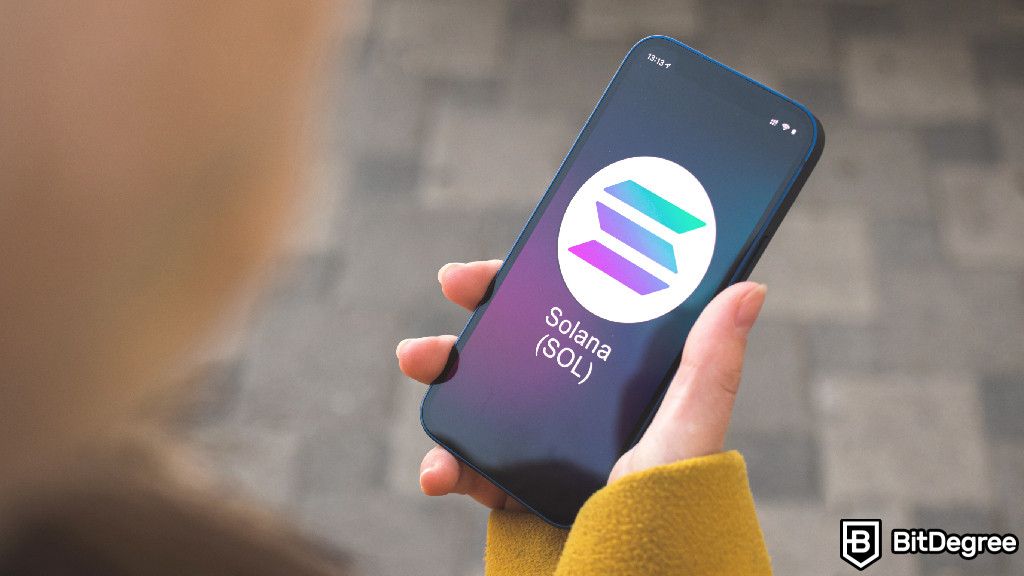Key Takeaways
- Staking SOL tokens allows investors to earn passive income by supporting the network’s operations;
- Effective staking involves several steps: setting up a Solana-compatible wallet, purchasing SOL tokens, and selecting reliable validators;
- Staking involves certain risks, such as lock-up periods and potential slashing penalties.
Ace quick missions & earn crypto rewards while gaining real-world Web3 skills. Participate Now! 🔥
In cryptocurrency, staking your assets to maintain the blockchain network has emerged as a popular method for investors to earn passive income. Solana, known for its high throughput and low fees, is an attractive option for those looking to get into this field. But how to stake Solana and what makes it so appealing?
Staking SOL involves delegating your tokens to support the asset's network operations. As a result, earning Solana staking rewards in return. Major exchanges like Binance and Kraken have made it easier to hold onto cryptocurrency and participate in network operations, such as transaction validations.
Understanding how to lock up a portion of your digital currency to support the operation and security of a blockchain network can become an invaluable skill. So, let's delve into it and start earning Solana staking rewards with your SOL tokens.

Did you know?
Subscribe - We publish new crypto explainer videos every week!
What is a Bitcoin & How Does it work? (Animated Explainer)
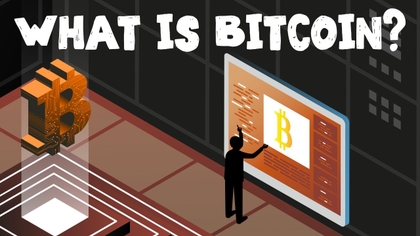

Table of Contents
- 1. How to Stake Solana: A Step-by-Step Guide
- 1.1. Setting Up Your Solana Wallet
- 1.2. Purchasing SOL Tokens
- 1.3. Transferring SOL to Your Wallet
- 1.4. Choosing a Validator
- 1.5. Staking Your SOL Tokens
- 2. What is Solana Staking?
- 2.1. Overview of Solana
- 2.2. Understanding Solana Staking
- 3. Benefits of Staking Solana
- 3.1. Passive Income
- 3.2. Supporting Network Security
- 3.3. Low Fees and High Throughput
- 4. Considerations of Staking Solana
- 4.1. Lock-Up Period
- 4.2. Slashing Risks
- 4.3. Validator Performance
- 5. Conclusions
How to Stake Solana: A Step-by-Step Guide
Before I provide an explanation on how to stake Solana, you must understand three prerequisite steps for staking your SOL tokens. First, you will need to either purchase a hardware wallet like Ledger Nano X or create a software one. Naturally, then you purchase SOL tokens, and transfer them to your address. That said, let's discuss each of these steps one by one.
Latest Deal Active Right Now:Don’t just pass GO, snag the limited edition Ledger Flex x Monopoly Bitcoin bundle and get a mystery BTC voucher worth up to $500. Hurry up, only available until the supply runs out!
Setting Up Your Solana Wallet
Setting up a Solana-compatible wallet is crucial before staking the assets, as it lets you securely store your SOL tokens and interact with the blockchain. You can choose between a hardware and software wallet. The former option, like Ledger Nano X, provides robust security by storing your private keys offline. On the other hand, software wallets offer convenience for frequent transactions on the go.
Additionally, compatibility is a key factor when selecting a wallet for staking Solana. Many popular wallets are designed to integrate seamlessly with staking platforms and validators. For instance, Ledger Nano X supports Solana staking, enabling users to delegate their SOL tokens to a validator directly using the device. This ensures you can manage your activities securely.
So, how do you set up a Solana wallet using Ledger Nano X? Follow the steps below:
Step 1: Download and install the Ledger Live application on your computer or mobile device.
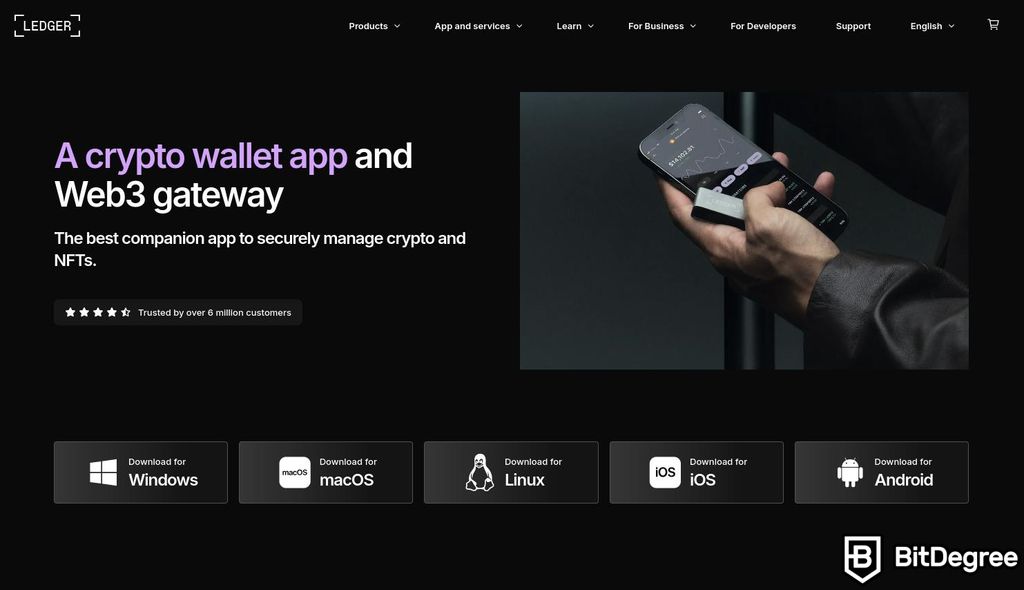
At the moment of writing, for Apple devices, it's recommended to use the latest iOS 13. Meanwhile, for the Android operating system, its suggested to use the 8.1 version. In addition, if you're using a computer, Ledger supports Windows, macOS, and Linux.
Step 2: Turn on your Ledger Nano X device by pressing the button next to the USB port.
Step 3: Press the left and right buttons on your Ledger device simultaneously until the [Set up as new device] option is displayed.
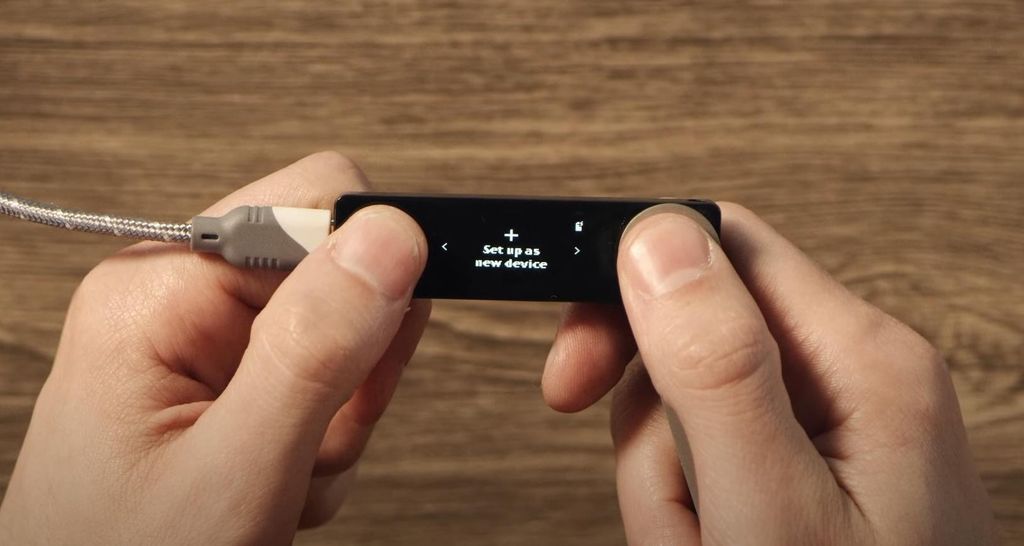
Step 4: Create a 4-to 8-digit PIN code and confirm it. Use the left and right buttons to enter the PIN digits.
Step 5: Press the left or right buttons until the Ledger device displays [Write down your recovery phrase].
Step 6: Take note of the 24-word recovery phrase displayed on the screen. Use the blank recovery sheet supplied in the box. Press the right button to move to the next word. On the last word, press both buttons to proceed.
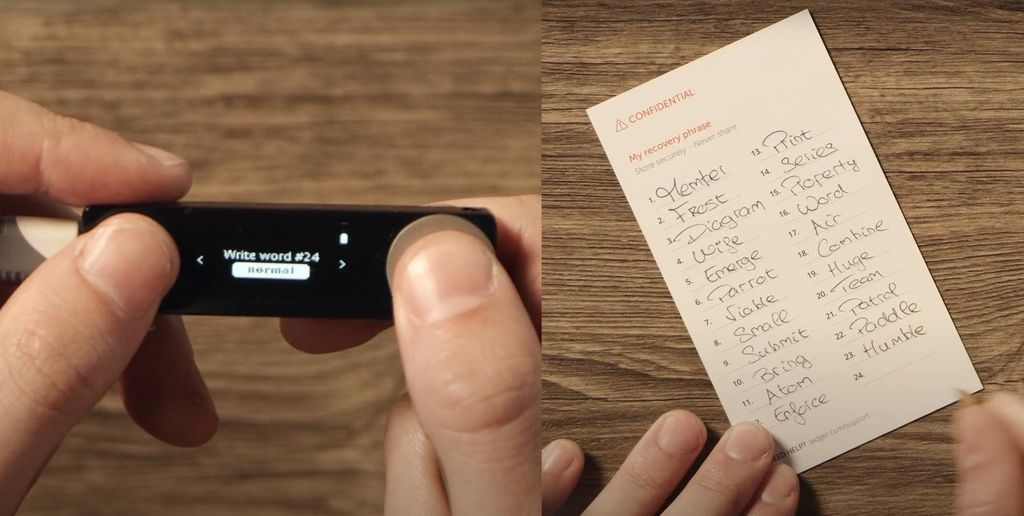
Step 7: Press both buttons until the [Confirm your recovery phrase] option is displayed.
Step 8: Select the first word written in position one on your recovery sheet with the left or right button. Repeat this to confirm your 24-word recovery phrase.
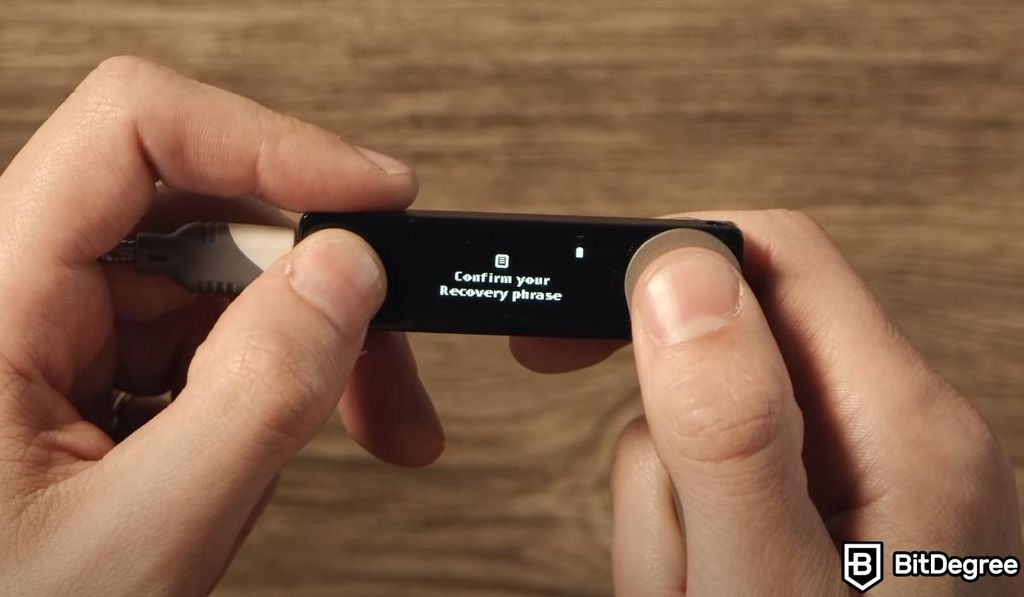
That’s it! Your Ledger Nano X device is ready. You’ll see a success confirmation with the message [Your device is ready]. Press both the left and right buttons to [Access Dashboard].
Purchasing SOL Tokens
Now that you’ve set up your Solana wallet, the next step is to purchase SOL tokens. To illustrate, I use Binance, the largest crypto exchange. Here’s a step-by-step guide on how to buy SOL on Binance using a debit or credit card:
Step 1: Go to the Binance website and log in to your Binance account. If you don’t have one yet and wish to use this exchange platform to stake Solana, you will need to sign up first. Remember that you need to verify your account through Know Your Customer (KYC) verification to access all features.
Step 2: Click the [Buy Crypto] link at the top navigation bar.
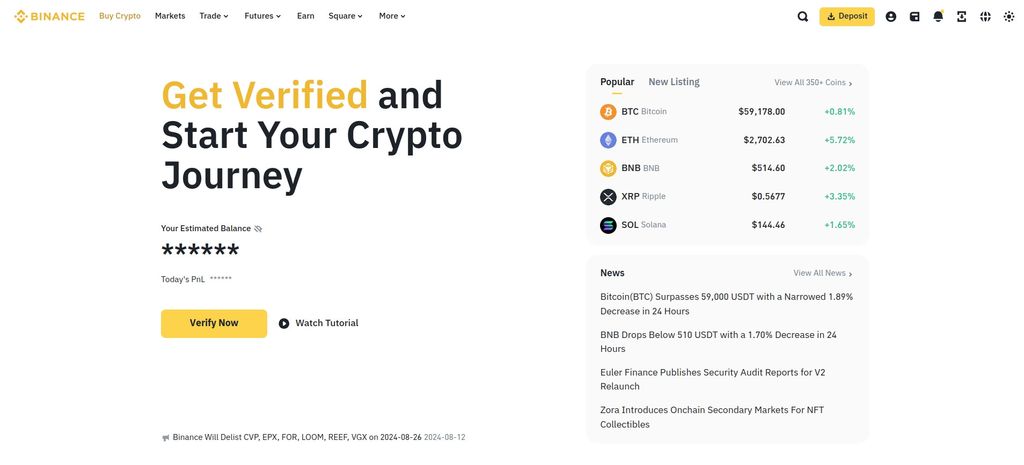
Step 3: Select your fiat currency in the [Spend] section and Solana (SOL) in the [Receive] section.
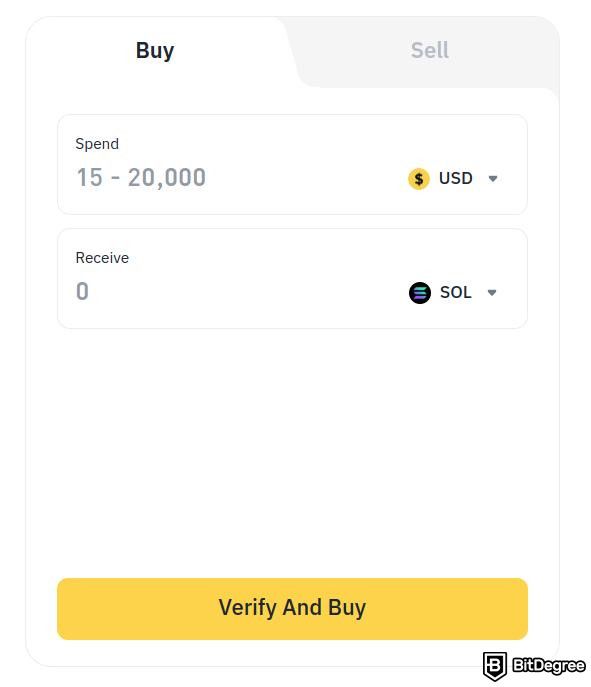
Step 4: Enter the amount you want to spend.
Step 5: Choose [Card] as the payment method and click [Confirm].
Step 6: If you haven’t connected a debit or credit card with your account, a pop-up window will appear. Click [Add New Card], enter card details, and click [Confirm].
Step 7: Verify details and confirm the order within the time limit. Then, click [Confirm] to place your order.
Step 8: You’ll be redirected to your bank’s OTP transaction page. Follow the instructions to verify the payment.
You’ve successfully purchased SOL tokens. Once the payment is verified, the coins will appear in your Spot Wallet.
Transferring SOL to Your Wallet
After buying your SOL tokens, you can transfer them to your Ledger Nano X for secure storage and staking. Here’s how you do it:
Step 1: Open the Ledger Live application and navigate to the [Manager] tab.
Step 2: Connect your Ledger Nano X to your computer and unlock it.
Step 3: Look for the Solana (SOL) app in the application catalog. Type "SOL" or "Solana" in the search field.
Step 4: Click the [Install] button to install the application.
That's all! You’ve set up a Solana account to transfer the tokens from exchanges to your Ledger device. Now, it’s time to withdraw the assets from Binance. Follow the steps below:
Step 1: Go to your Binance account. Click the [Wallet] icon at the top navigation menu and select [Overview].
![]()
Step 2: Choose SOL and click [Withdraw].
Step 3: Select the Solana network for SOL tokens.
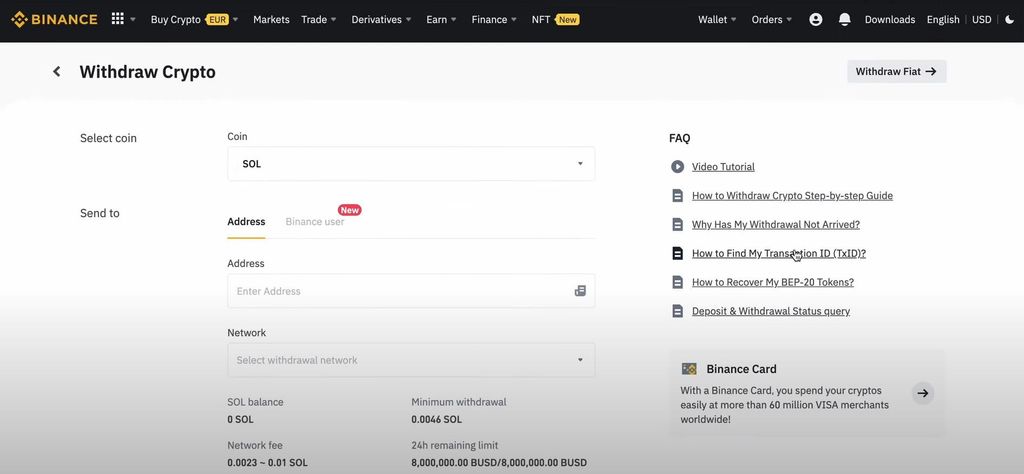
Step 4: Connect your Ledger Nano X to your computer.
Step 5: Open the Ledger Live app and click [Receive]. Select Solana from the dropdown menu and click [Continue].
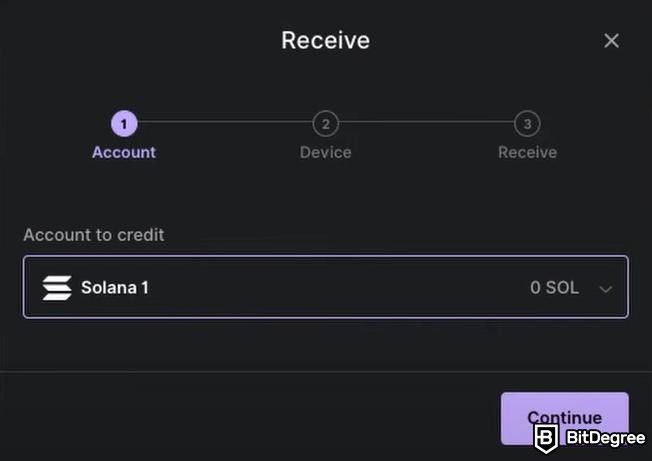
Step 6: Your deposit address will be displayed. Copy the shared address once you've verified it matches the one on your Ledger device.

Step 7: Return to your Binance account and paste the deposit address in the [Address] field.
Step 8: Click [Withdraw]. Go through the two-factor authentication (2FA).
Congratulations! You’ve transferred your SOL tokens from Binance to Ledger Nano X. Wait until the transaction is processed and complete.
Now, it's time to discuss the steps on how to stake Solana. Performing this action involves selecting a validator and delegating your SOL tokens. Let's get into it.
Choosing a Validator
Validators play a crucial role in securing the Solana network and processing transactions. Remember that when you stake your SOL tokens, you entrust them to a validator, who then uses the delegated assets to participate in the network’s consensus process.
That said, I recommend researching validators to determine where to stake Solana. This will help you find the right one and maximize your returns.
Consider the following several factors to choose the best place to stake Solana for optimal returns and network support:
- Performance and reliability: Choose validators with a proven reliability and uptime track record. Well-grounded validators ensure that your efforts contribute effectively to the network and maximize your Solana staking rewards.
- Commission rates: Validators charge a commission on the rewards earned. Lower commission rates mean you keep more of your Solana staking yield and Solana staking APY.
- Reputation: Research the validator’s reputation to find the right and best place to stake Solana within the community. Validators with positive feedback and active participation in the community are often more trustworthy.
- Staking capacity: Ensure the validator has sufficient capacity to accept your delegation without being oversaturated, which could impact your rewards.
If you’re looking for the best place to stake Solana, you can use resources like SolanaBeach.io or Solscan.io. These platforms provide detailed information on validator performance, commission rates, and other essential metrics.
By carefully selecting where to stake Solana, you can enhance the Solana staking yield and Solana staking APY. Therefore, you can maximize your investment while contributing to the network’s security and efficiency.

Did you know?
Subscribe - We publish new crypto explainer videos every week!
Layer 2 Scaling Solutions Explained With Animations


Staking Your SOL Tokens
After choosing your preferred validator, the next step is delegating your SOL tokens. Deciding where to stake Solana involves considering whether to use a self-custodial wallet or an exchange.
A self-custodial wallet like Ledger Nano X provides greater control over your assets and enhanced security, as your private keys remain offline. Though, you can also stake your SOL tokens through an exchange like Binance and Kraken. These platforms handle most technical parts and offer a user-friendly and convenient staking process.
For example, I use Ledger Nano X to help you get started. Here’s a step-by-step guide on how to stake Solana:
Step 1: Connect your Ledger Nano X device to your computer or phone and open the [Solana app] on your device. When you open the Solana application, your Ledger device should display [Application is ready].
Step 2: Open Ledger Live. Navigate to the [Accounts] tab and select your Solana account.

Step 3: On the Solana account screen, click the [Stake] button.
Step 4: Select a validator and click [Continue]. You can also click on [Show all] to see all Solana validators. Ledger Live can display the top 1,000 validators for the moment.
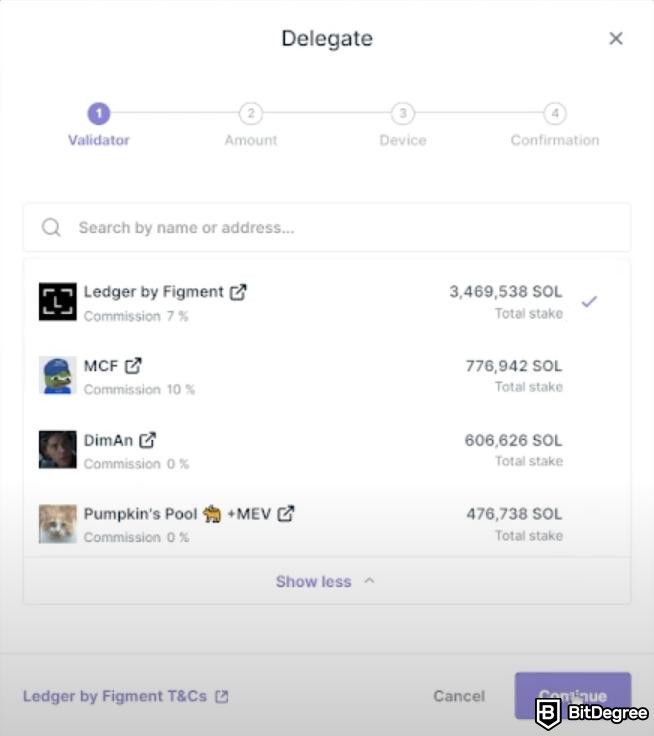
Step 5: Enter the amount of SOL tokens you wish to delegate and click [Continue]. A prompt will appear on your Ledger device.
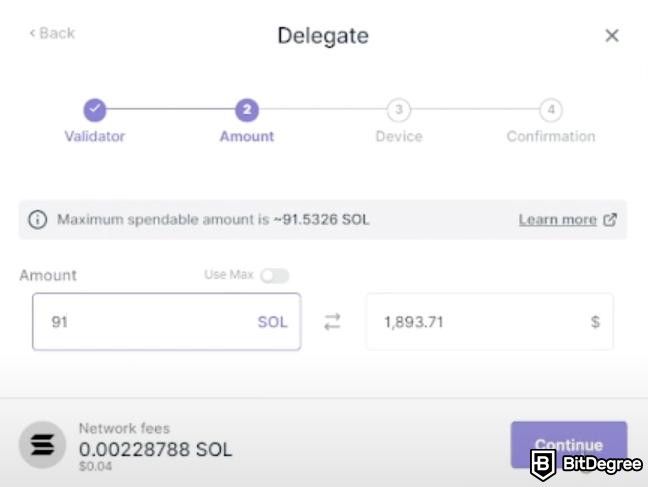
Step 6: Review and approve the transaction on your Ledger device. Once you’ve confirmed the transaction, the screen should display [Broadcasting transaction] and [You have successfully delegated your assets] when it’s finished.
Congratulations! You’ve successfully staked your SOL tokens. It's worth noting that your balance will take up to three days to become active and earn rewards.
What is Solana Staking?
Now that you’ve learned how to stake Solana, let’s explore more about Solana. So, what is Solana?
Overview of Solana
Solana is a high-performance blockchain that provides fast and scalable decentralized applications (dApps) and cryptocurrencies. Known for its impressive speed, Solana can process thousands of transactions per second thanks to its innovative architecture that combines proof-of-history (PoH) and proof-of-stake (PoS) consensus mechanisms.
Let’s discuss both of them in more detail. So, PoH is designed to create a historical record that proves that an event has occurred at a specific moment in time. On the other hand, PoS secures the network and validates transactions. In PoS, validators are selected based on their stakes, such as contributions to the Solana network[1].
This unique combination enables Solana to achieve high throughput and low transaction costs. Therefore, it becomes one of the preferred choices for investors and developers.
Understanding Solana Staking
When learning how to stake Solana, you might wonder what it is in the first place. Staking in cryptocurrency involves participating in the network’s consensus mechanism by locking up a certain amount of your tokens[2]. This process helps secure the network, validate transactions, and maintain the blockchain.
In return, you earn rewards, which can be a great way to generate passive income. Understanding how to stake Solana is particularly valuable due to its efficiency and potential rewards.
That said, you might be wondering how exactly does it work? It starts with users delegating their SOL tokens to validators. By the way, validators are responsible for processing transactions and adding new blocks to the blockchain. When you stake your SOL tokens, you entrust them to a validator. However, this process doesn’t transfer ownership of your tokens, so you retain full control and can un-stake them.
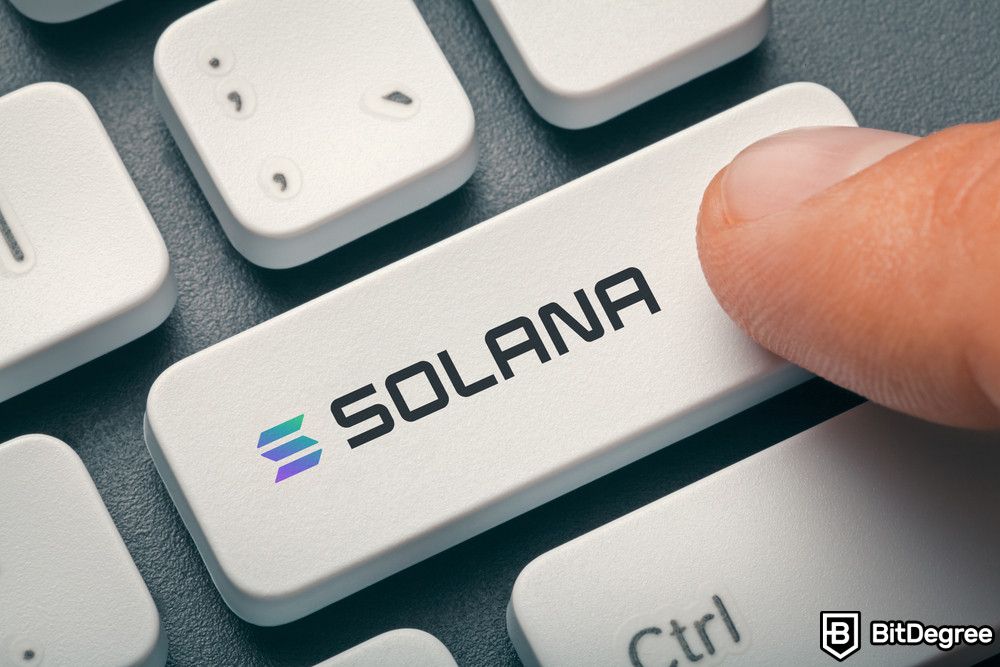
Then, validators use the staked tokens to enhance their chances of being selected to verify transactions and produce new blocks. In return, you share the rewards the validator earns, reflected in your Solana staking yield and APY (annual percentage yield).
The former can vary based on several factors, including the total amount of SOL staked and the network's overall performance. Additionally, Solana staking APY measures your potential annual return, which is expressed as a percentage.
Overall, this is a strategy for crypto investors to enhance their portfolio’s performance. By understanding how Solana staking works and the role of validators, you can effectively contribute to the network’s security while earning rewards.
Benefits of Staking Solana
By understanding how to stake Solana, you can unlock various benefits that enhance your investment and support the overall health of the network. So, what are the advantages of staking Solana?
Passive Income
A benefit of knowing how to stake Solana is the ability to generate passive income. By staking SOL tokens, you earn rewards for participating in the network’s validation process. These rewards are distributed periodically, often based on the predefined intervals on the Solana network, known as the epochs.
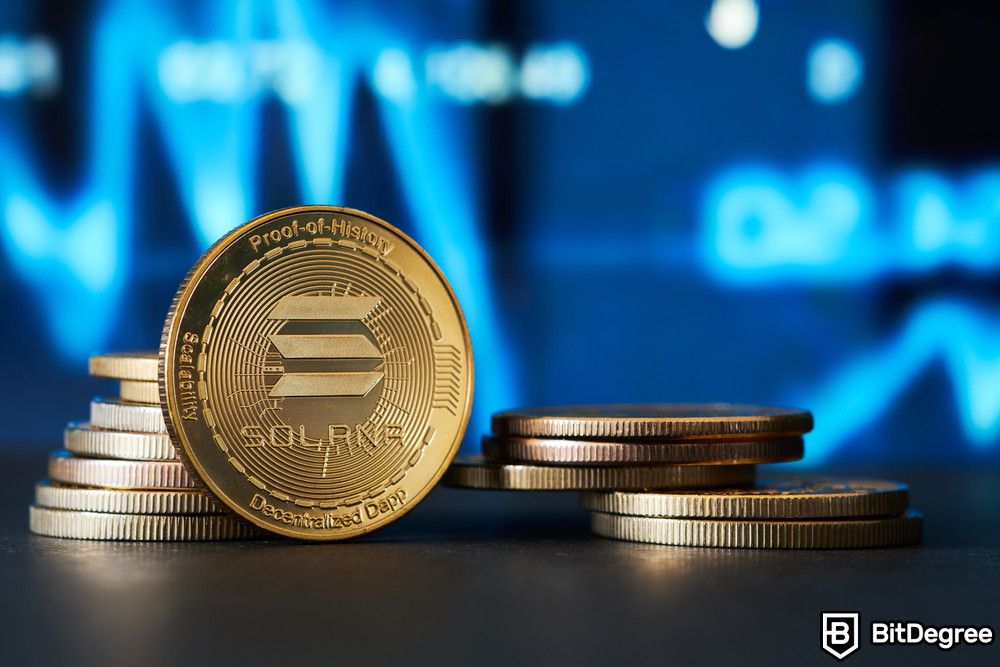
Solana staking rewards can vary based on several factors. These include the total amount of SOL locked and the performance of the validators.
Moreover, Solana staking yield and Solana staking APY are measures of these returns, which provide insights into the potential earnings you can expect. For example, if you lock 1,000 SOL tokens and the average APY is 6%, you could earn approximately 60 SOL annually.
Learning how to stake Solana and regularly monitoring your staking performance can optimize your earnings and investment.
Supporting Network Security
The action of locking your tokens into a contract plays a vital role in promoting the security and decentralization of the network. By understanding how to stake Solana, you can actively contribute to maintaining the network’s integrity and preventing malicious attacks.
This process enhances network decentralization by distributing the task of validating transactions among many validators. This helps ensure that no single entity controls the network.
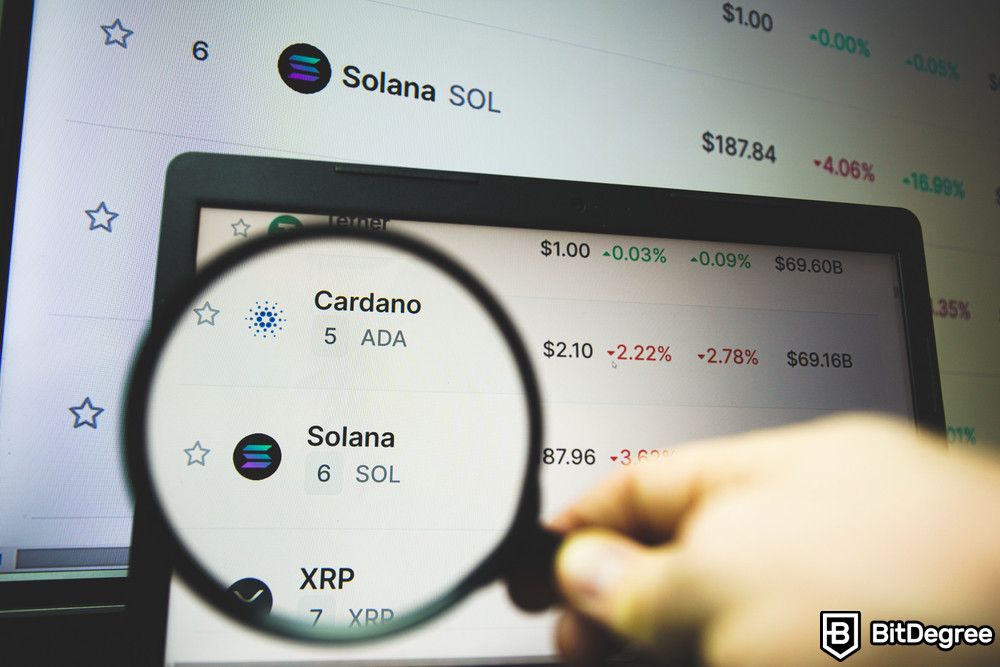
So, how do you support Solana blockchain with staking? Well, when you delegate SOL tokens to validators, you support these validators in maintaining the network’s operations. The more tokens a validator has staked, the more influence they have in the network, which can directly impact its stability.
By participating in staking Solana, you help ensure the network remains decentralized and secure, which benefits all users. So, knowing how and where to stake Solana can maximize your rewards while contributing to the network’s robustness and integrity.
Low Fees and High Throughput
One of Solana’s most compelling features is its low transaction fees. These low fees are especially beneficial for users who engage in frequent transactions or use the network for various applications.
Solana’s high throughput is another critical advantage, supporting large-scale applications and enabling the network to handle thousands of transactions per second. This capability is made possible by Solana’s innovative consensus mechanisms – PoH and PoS. These mechanisms allow for fast and efficient transaction processing without compromising security.
The low fees and high throughput significantly enhance Solana's user experience. Users benefit from fast transaction confirmations and the ability to perform numerous transactions without worrying about high costs. This efficiency is crucial for dApps, decentralized finance (DeFi) projects, and other large-scale blockchain solutions.
Considerations of Staking Solana
While staking Solana offers numerous benefits, there are also several considerations to keep in mind. Understanding these factors is crucial for anyone looking to learn how to stake Solana effectively. Let’s explore the considerations of staking your SOL tokens.
Lock-Up Period
It’s important to consider the lock-up period when learning how to stake Solana. A lock-up period is when your staked SOL tokens are immobilized and cannot be withdrawn or transferred. This period is essential for maintaining the network’s stability and preventing sudden large-scale withdrawals that could disrupt the blockchain’s operations.
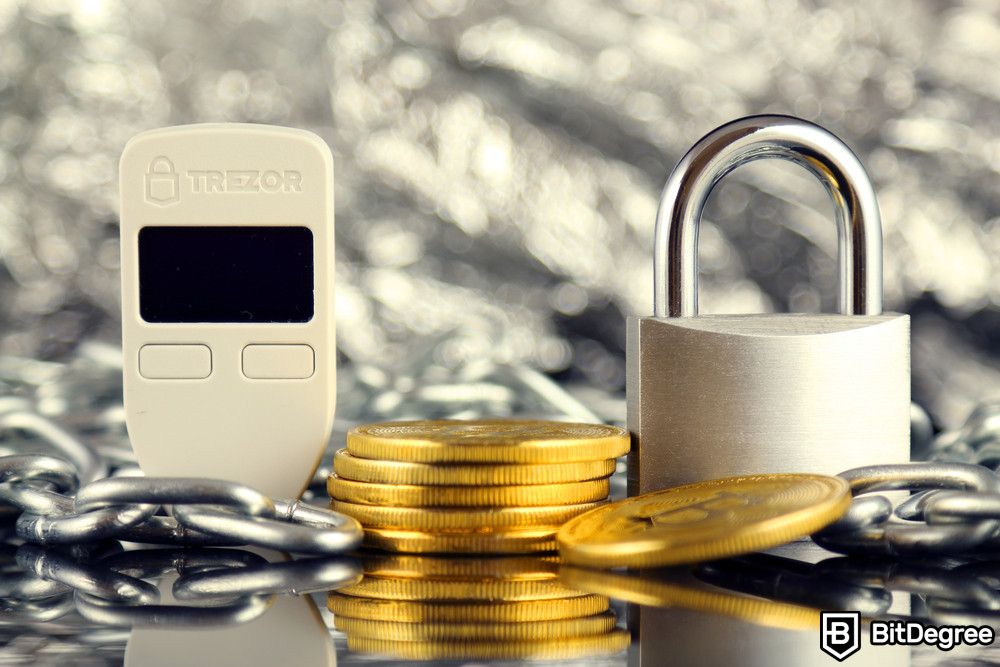
In Solana staking, the standard lock-up period is approximately two days. During this time, any staked tokens that are being un-delegated won’t earn rewards, and they remain inaccessible until the period ends.
Unfortunately, the lock-up period can impact liquidity and access to funds. When you stake your SOL tokens, you should know you won’t have immediate access if needed. This lack of liquidity can be a drawback, especially in emergencies or financial needs. So, it’s crucial to only stake the amount of SOL you’re comfortable locking up for the specified period.
Understanding the implications of the lock-up period is vital for effective staking. By planning and considering potential emergency scenarios, you can ensure that staking Solana aligns with your financial strategy. This careful consideration will help you maximize the benefits while also mitigating the risks associated with restricted access to your funds.
Slashing Risks
Slashing is another important term you should know if you’re learning how to stake Solana. It’s a mechanism used in PoS blockchain networks to penalize validators and delegators when certain types of misbehavior occur[3]. The purpose is to ensure the security and integrity of the network by deterring malicious activities and maintaining trust among participants.
Slashing can occur for several reasons, including validator misbehavior and network errors. Regarding the former one, double-signing and downtime are common types of misconduct that can lead to slashing.
Double-signing happens when a validator signs two blocks at the same height, creating conflicting chains and threatening the network’s consensus. Downtime refers to periods when a validator is offline and not participating in the network’s activities, which can negatively impact network performance and reliability.

Although Solana doesn’t implement slashing penalties (as of writing), the network plans to introduce slashing rules to enhance security. Validators who engage in malicious activities, such as creating invalid transactions or censoring them, could see a portion of their staked tokens removed from circulation as a penalty.
To minimize the risk of slashing, investors can take several steps:
- Choose reliable validators: Select validators with a proven track record of reliability and uptime. This reduces the risk of downtime and other forms of misbehavior.
- Diversify delegations: Spread your stake across multiple validators to reduce the impact if one validator is slashed. Diversification helps mitigate the risks associated with any single validator’s actions.
- Monitor validator performance: Regularly check the performance and behavior of the validators you have delegated to.
By carefully selecting validators and monitoring their performance, you can minimize slashing risks and protect your investment.

- Secure and reliable
- Accepts fiat currencies
- Lots of trading options
- Reputable exchange
- Accepts fiat currencies
- Offers various trading options

- Accepts fiat currencies
- Simple to use
- Supports only trusted cryptocurrencies
- A leading cryptocurrency exchange platform
- Best for all type investors
- Accepts fiat currencies

- Beginner-friendly
- Secure
- Decent trading and withdrawal fees
- Crypto.com Visa Card
- Automated tools & bots
- Ecosystem synergy with CRO
Validator Performance
Validator performance is a critical factor in determining the success of your staking efforts on the Solana network. High-performing validators not only ensure the network’s security but also maximize your staking rewards.
So, it’s important to assess validator performance when you’re learning how to stake Solana. There are several key metrics to consider:
- Uptime: This measures the percentage of time a validator is active and operational. High uptime is crucial for earning consistent rewards. Solana validators generally aim for near 100% uptime to ensure continuous participation in the network.
- Commission rates: Validators charge a commission on the rewards earned. Lower commission rates mean you retain more of your staking rewards. It’s important to balance commission rates with the validator’s reliability.
- Performance metrics: Metrics such as transaction processing speed, block production efficiency, and the validator’s contribution to the network’s security are vital. Platforms like Solscan.io and SolanaBeach.io provide detailed performance statistics for validators.
Validator reputation also plays a significant role in ensuring reliable performance. So, validators with a strong track record and positive community feedback are generally more trustworthy and less likely to engage in behaviors that could lead to slashing or downtime.
Conclusions
Understanding how to stake Solana provides a means to earn passive income and contribute to the network's security and efficiency. By staking SOL tokens, you engage in a process that not only benefits you through rewards but also supports Solana's decentralized ecosystem.
Setting up a Solana-compatible wallet, such as Ledger Nano X, purchasing SOL tokens, and choosing reliable validators are the steps to get a successful staking experience. The choice of validator impacts your staking rewards, and careful consideration of factors such as performance, reliability, and commission rates is crucial.
Staking also involves understanding the risks, such as the lock-up period and potential slashing. Although Solana doesn’t yet implement slashing penalties, staying informed about validator performance and potential risks can safeguard your investments.
Wrapping up, staking Solana is a strategic way to enhance your portfolio and support a robust blockchain network. By learning how to stake Solana, you can optimize your returns while contributing to the growth and security of the Solana ecosystem.
The content published on this website is not aimed to give any kind of financial, investment, trading, or any other form of advice. BitDegree.org does not endorse or suggest you to buy, sell or hold any kind of cryptocurrency. Before making financial investment decisions, do consult your financial advisor.
Scientific References
1. C. Nguyen, D. Hoang, D. Nguyen, et al: ‘Proof-of-Stake Consensus Mechanisms for Future Blockchain Networks: Fundamentals, Applications and Opportunities’;
2. C. Cipollini: 'Crypto Staking Taxation Across Selected Countries: A Critical Evaluation';
3. K. Gogol, C. Killer, M. Schlosser, et al: ‘Decentralized Finance (DeFi): Fundamentals, Taxonomy and Risks’.

